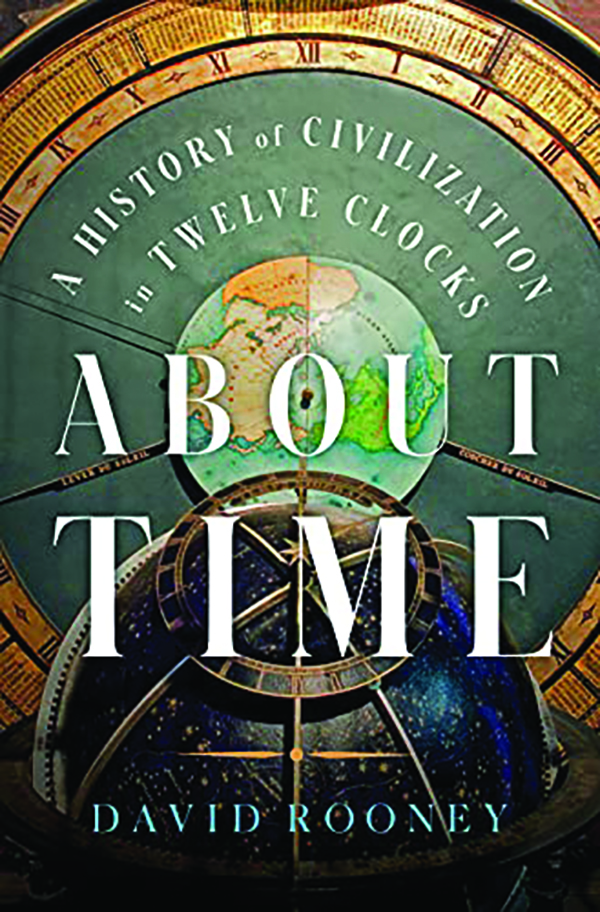Clocks have been used for millennia to keep and measure time. Ancient civilizations used sundials and water clocks; since then, there have been candle clocks, incense clocks, hourglasses, mechanical clocks, electric clocks, and atomic clocks. The advent of the wristwatch in the 19th century enabled people to check the time whenever they pleased; today, many of us prefer the convenience of the iPhone.

But the noble clock is more than just a timekeeping device. It also helps to explain our history.
“A history of clocks is a history of civilization,” David Rooney writes in About Time: A History of Civilization in Twelve Clocks. The author knows his subject rather intimately. He’s a historian of technology, former curator of timekeeping at Greenwich’s Royal Observatory, and the son of a British clockmaker. “With clocks,” he notes, “the elites wield power, make money, govern citizens and control lives.” By examining 12 clocks associated with 12 unique moments in history, Rooney tells a fascinating story about how clocks have not only kept the time for us but also defined the times we’ve lived in.
The book’s first clock is a sundial in the Roman forum, which Rooney dates to 263 B.C. It was brought to the city as war booty by the consul Manius Valerius Maximus, who seized it during the capture of the Sicilian city of Catania. The public display of time was, from the beginning, a display of power. Valerius mounted the sundial “on a column that bore his name,” and it was seen by adoring crowds as proof that Rome was “on top.”
What Valerius never could have envisioned was that his triumphal sundial would be joined by others. Soon, the authorities were erecting public sundials all over the city in order to “regulate and control the myriad daily activities of Rome’s citizens — who quickly became uneasy at the intrusion of this new timekeeping technology.” Frustrated playwrights and critics “poured scorn on the new devices.” Many ordinary Romans came to despise the devices they had originally welcomed with open arms.
Rooney asks us to think of Valerius’s sundial as the great city’s first clock tower, a public symbol of the might of Rome. Later, the global empires of Europe would follow the consul’s example. As the 19th century crossed into the 20th, Rooney writes, “clock towers had matured into structures that helped express the power of the government at a distance,” becoming “architectural proxies for the state itself.”
In another chapter, Rooney examines the clock tower located at the Amsterdam Stock Exchange building that opened in August 1611. In addition to symbolizing the city’s commercial power, it helped the authorities regulate the exchange. It tolled a bell at noon for seven and a half minutes, and any stock traders still conducting their business in the exchange or on the streets after it stopped would be fined. The same thing occurred at the end of evening trading.
This clock and others “made trading more efficient.” By ensuring that stock and commodity trades could only occur in a specific time frame, public timekeeping helped prices remain fair at the stock exchange and “could be used to regulate the people who occupied intermediate roles in the functioning of a market.” The Amsterdam exchange, unlike other stock exchanges of that time in London and Antwerp, had a clock tower that didn’t regularly break down or have major mechanical problems, and it was “accurate to better than half an hour a day.” When it tolled, Rooney writes, it was “sounding the birth of modern capitalism.”
In another fascinating chapter, Rooney looks at the Samrat Yantra (“The Supreme Instrument”) in Jaipur, India, during the time period of 1732-1735. An astronomical observatory constructed during the reign of Maharaja Sawai Jai Singh II, the clock is still considered the “world’s largest sundial.”
Jai Singh’s goal in building the observatory was to “show the world that he was at the center of the universe,” a purpose for which he first assembled a team of Islamic and Hindu experts before recruiting Christian astronomers from Europe. Boasting of his multinational cast of advisers, Jai Singh declared himself a sun king.
Another of the clocks mentioned in About Time is the telescope driving clock, which was a “clockwork device for timing observations” that stayed “fixed on a star while the Earth rotated,” located in the Royal Observatory in Edinburgh, Scotland. On May 21, 1913, a bomb exploded in the observatory. Someone had placed a large earthenware jar next to an iron staircase leading to the western telescope dome; the jar was “packed with gunpowder” and “connected by a thirty-foot fuse” that ran down to the room where the driving clock was located.
The culprits were never identified or caught. Two notes left behind proved it was the handiwork of Scottish suffragettes, who had left another bomb in a Dalkeith chapel a few days before. Why would they target telescopes and clocks? Rooney suggests it had to do with the “standardization of time,” which the suffragettes saw as “an act of power and control.” The instruments in the observatory were, in the bombers’ view, “tyrants” that were part of a system “stacked against women.”
“Clocks are tools at our disposal,” Rooney concludes. “If we understand where our clocks have come from … we might be better equipped to criticize, and more often, resist” the urge to use them to control people. Is he right? Time will tell.
Michael Taube, a columnist for Troy Media and Loonie Politics, was a speechwriter for former Canadian Prime Minister Stephen Harper.

